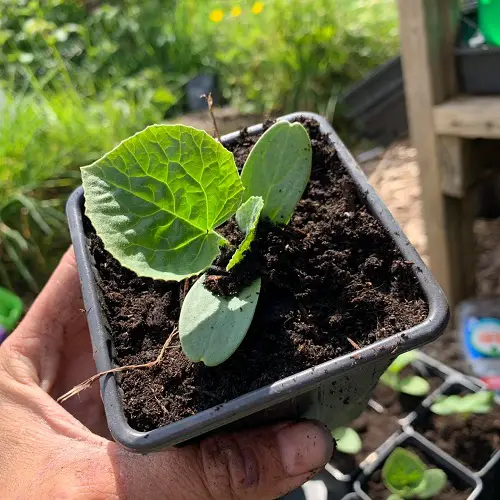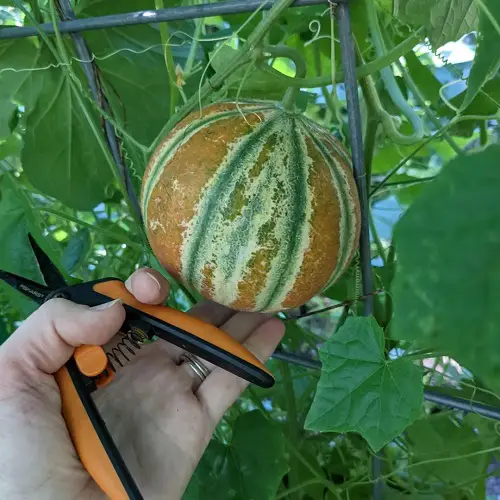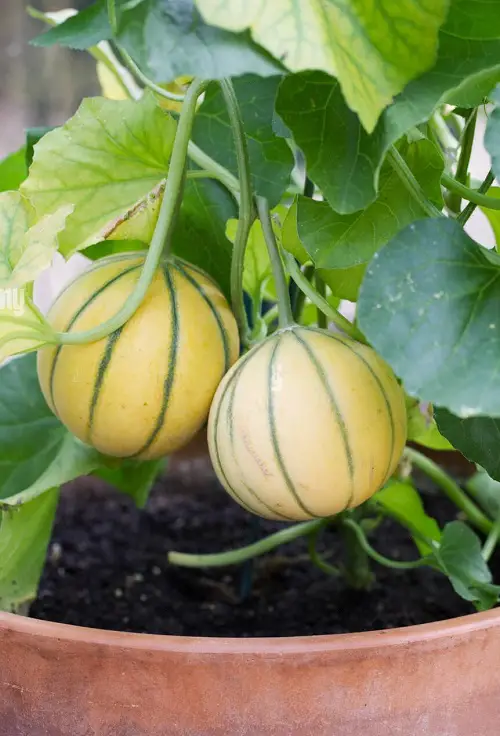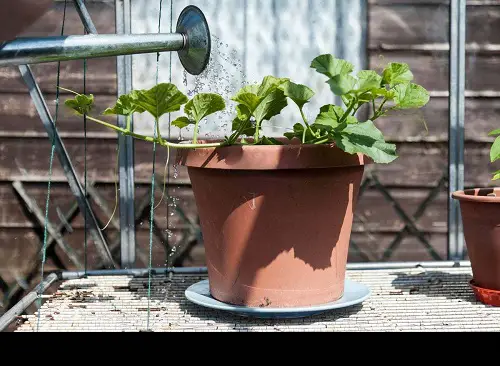Learn How to Grow Kajari Melon in Pots and Garden with our comprehensive guide so you always have sweet and juicy delights.

Are you looking for sweet and juicy fruit to grow in your garden or on your balcony? Look no further than the Kajari Melon! Here is everything you need to know about growing it!
Kajari Melon Plant Information
Kajari melon is an annual herbaceous plant that is native to India. It is also commonly referred to as “Indian melon” or “Kharbuja” in some parts of India. The plant produces yellow-orange fruits that are oval in shape and have a sweet and juicy flavor.
It has many medicinal properties and is used in traditional medicine to treat a variety of ailments. The plant is also used in some parts of India as a food crop due to its sweet taste and juicy texture.
This annual vine grows up to 5-6 feet long, producing multiple fruits along the way. It prefers warm temperatures, making it an ideal addition to any garden or balcony.
Is Watermelon a Fruit or a Vegetable?
Propagating Kajari Melon
- Seed propagation: For this most common method, you can purchase Kajari melon seeds from a reputable seed supplier or collect seeds from a mature Kajari melon. Sow the seeds in rich, fertile soil and provide them with plenty of sunlight and water. With proper care, the seeds will germinate and grow into healthy Kajari melon plants.
- Stem cuttings: You can also stem cut a mature Kajari melon plant. Remember to cut a stem with at least two leaves and remove the bottom leaves. Dip the cut end of the stem in rooting hormone and plant it in moist soil. Keep the soil moist and provide the cutting with bright, indirect light. With time, the stem will develop roots and grow into a new Kajari melon plant.
- Grafting: This is a more advanced method of propagation that involves combining the top part of a Kajari melon plant with the rootstock of a different type of melon plant. This method is often used to create hybrid varieties with desirable traits.
How to Grow Kajari Melon in Pots
1. Choosing a Pot
Select a pot that is at least 12-14 inches deep and wide, with good drainage holes at the bottom. This will allow the Kajari melon roots to grow deep and prevent waterlogging.
2. Preparing the Soil
Mix high-quality soil with compost to enrich the soil and provide the plant with essential nutrients. Kajari melon requires well-draining soil, so add sand or perlite if your soil is too heavy.
3. Sowing the Seeds

Sow the Kajari melon seeds directly in the pot, 1-2 inches deep. You can plant 2-3 seeds in each pot and thin out the weaker seedlings later. Cover the seeds with soil and water thoroughly.
4. Providing Support
Kajari melon is a vining plant and requires support to grow. Place a trellis or support system in the pot before sowing the seeds, or add it later when the seedlings start to grow.
5. Watering
Water the Kajari melon plant regularly, especially during hot weather. Keep the soil moist but not waterlogged, as overwatering Kajari Melon can cause root rot.
How to Grow Kajari Melon in a Garden
1. Choosing a Garden Space

Select a garden space with full sun exposure for at least 6 hours daily. Kajari melon thrives in warm temperatures and requires plenty of sunlight to grow.
Choose a well-drained spot free of weeds, rocks, or other obstructions that could hinder growth.
2. Preparing the Growing Medium
Prepare the garden soil by enriching it with compost and high-quality soil. Mix well to ensure an even distribution of nutrients. Kajari melon requires well-draining soil, so look for heavy soil.
If your soil is heavy, add some sand or perlite to make it suitable for the Kajari melon to ensure healthy growth and a bountiful harvest.
3. Providing Support
Kajari Melon requires a support structure for optimum growth. Before sowing the seeds, place a trellis in the garden.
You can also add one later when the seedlings appear to help the plant grow upright, keep the fruit off the ground, and make harvesting easier.
Kajari Melon Care

Fertilizer
Use a balanced liquid fertilizer with a ratio of 10-10-10. Dilute it to 1/2 of its strength and use it every 2-3 weeks to boost fruit production in plants.
Make sure to water the soil after fertilizing to help the nutrients reach the roots. It is also beneficial to add some organic matter, such as compost or aged manure, to the soil before planting. This will improve the soil structure and help retain moisture.
Pruning
Pruning Kajari Melon plants is essential to promote healthy growth and maximize fruit production. Remove the lateral shoots that develop between the main stem and the leaves.
Once the main stem reaches the desired length, pinch off the growing tips. This will help the plant focus its energy on fruit development.
Regular pruning will also help to keep the plant’s size in check, prevent overcrowding, and improve air circulation, reducing the risk of disease.
Pests and Diseases
Kajari melon plants are susceptible to various pests and diseases, including aphids, spider mites, powdery mildew, and fusarium wilt.
- Inspect your plants regularly and look for signs of damage or infestation, such as yellowing leaves, white powder, or webbing.
- Use organic insecticides or fungicides to control pests and diseases, or try companion planting with plants that repel pests, such as marigolds or garlic.
- Rotate your crops every year to prevent the buildup of soil-borne diseases. Finally, practice good garden hygiene by removing dead leaves, fallen fruit, and other debris from the garden.
Best Trellis to Support Kajari Melon
- A-frame trellis: This type of trellis is made by creating a frame with two large posts and then running two smaller beams across the top of the frame, creating an “A” shape. You can then string wire or twine across the beams to provide support for the Kajari melon vines.
- T-shaped trellis: This type of trellis is made by creating a tall T-shaped frame with one vertical post and one horizontal beam. Then, additional horizontal beams can be added at intervals, and wire or twine can be strung across them to create support.
- Fence trellis: If you have a sturdy fence, you can use it as a trellis for your Kajari melon plants. Simply attach wire or twine to the fence at intervals and train the vines to grow along the fence.
- Teepee trellis: This type of trellis is made by creating a teepee-shaped frame with several long poles. The poles can be tied together at the top to create a point, and then wire or twine can be strung between them to create support.
Here are the Best DIY Trellis for Plants Ideas (Indoors and Outdoors)
Harvesting Kajri Melon
When ripe and ready to be harvested, the melon will be a light yellow-green color. The size of the melon will also indicate ripeness; it should be medium-sized and firm to the touch. The stem should be dry, and the underside of the melon should be slightly yellow. The melon should also have a light, sweet aroma.
Once the melon is ripe, it should be harvested by cutting the stem with a sharp knife. It should then be stored in a cool, dry place. Kajri melons should be eaten within a few days of harvesting for the best flavor.




